
International Research Journal of Engineering and Technology (IRJET) e-ISSN: 2395-0056
Volume: 11 Issue: 08 | Aug 2024 www.irjet.net p-ISSN: 2395-0072


International Research Journal of Engineering and Technology (IRJET) e-ISSN: 2395-0056
Volume: 11 Issue: 08 | Aug 2024 www.irjet.net p-ISSN: 2395-0072
Dhadkan Shrestha1 , Peshal Nepal2 , Pratik Gautam3, Pradeep Oli4
1Texas State University, San Marcos, TX, US 78666
2Georgian College, Barrie, ON L4M 3X9, Canada
3Georgian College, Barrie, ON L4M 3X9, Canada
4Thapathali Engineering Campus, Kathmandu, Nepal
Abstract - Human Pose Estimation (HPE) is a critical technology in computer vision with diverse applications ranging from healthcare to sports analysis. This project presents a method for detecting the 2D stance of multiple persons in an image using a nonparametric representation known as Part Affinity Fields (PAFs). By leveraging the first 10 layers of the VGG-19 convolutional neural network and training on the COCO dataset, our model effectively identifies andassociates keypoints ofthehumanbody.
The architecture employs a two-branch system that jointly learns part locations and their associations through sequential prediction. This enables the model to maintain real-time performance while achieving high accuracy, regardless of the number of persons in the image. To enhance accessibility, we developed a mobile application using Flutter and TensorFlow Lite, allowing real-time pose estimation via a mobile device’s front camera. The app provides immediate feedback on physical exercises and yoga poses, making it an invaluable tool for fitness enthusiasts and healthcare professionals. Visual outputs such as heatmaps and PAFs confirm the model’s capability to accurately localize and connect key points. Despite potential challenges such as data quality and hyperparameter tuning, the results indicate that our approach is both reliable and practical for real-world deployment. This project not only advances the state-of-the-art in HPE but also opens possibilities for future enhancements, including integrating 3D pose estimation and applying the technology in augmentedandvirtualrealityapplications.
Key Words: HumanPoseEstimation(HPE),Convolutional Neural Network (CNN), VGG-19, Part Affinity Fields (PAFs),COCODataset,Real-TimePoseDetection
1.
Human Pose Estimation (HPE) is the process of identifying, tracking, predicting, and classifying the movement and orientation of the human body through input data from images or videos. It captures the coordinates of the joints, including the knees, shoulders, and head. The three primary approaches to modeling a human body are Skeleton-based, Contour-based, and Volume-basedmodels[1].HPEhasbeenevolvingwiththe
advancementofartificial intelligenceandhasapplications inhuman-computerinteraction,augmentedreality,virtual reality,trainingrobots,andactivityrecognition[2]. HPEis critical in various fields such as healthcare, sports, and entertainment.Inhealthcare,itisusedformonitoringand analyzing physical therapy exercises to ensure patients perform movements correctly, reducing the risk of injury. Insports,itaidsin performanceanalysis,helping athletes improve their techniques. In entertainment, HPE enables the creation of more interactive and immersive experiencesinvideogamesandvirtualreality.
There are several approaches to modeling a human body in pose estimation, which can be broadly categorized into threetypes:
Skeleton-based Models: These models represent the human body as a collection of joints connected by bones. The coordinates of the joints are tracked over timetounderstandthemovementandposture.
Contour-based Models: These models focus on the outer contour of the body, capturing the silhouette to inferposeandmovement.
Volume-based Models: These models create a volumetric representation of the body, capturing the full 3D structure, which is useful for more detailed analysis.
HPEcanbedividedintotwoprimarytechniques:
2D Pose Estimation: This technique involves estimating keypointsinthejointsofthehumanbodyinthe2Dspace for the image or video. It serves as a foundation for more advanced computer vision tasks like 3D human pose estimation,motionprediction,andhumanparsing.
3D Pose Estimation: This technique involves estimating the actual spatial positioning of the body in the 3D space, introducing the z-dimension. It provides a more comprehensive understanding of the body’s posture and movement[3].

International Research Journal of Engineering and Technology (IRJET) e-ISSN: 2395-0056
Volume: 11 Issue: 08 | Aug 2024 www.irjet.net p-ISSN: 2395-0072
With the advancement of deep learning and computer vision, significant progress has been made in HPE. Convolutional Neural Networks (CNNs) have been widely used to improve the accuracy and efficiency of pose estimation. Libraries such as OpenPose, DeepCut, and AlphaPosehave been developed,offering robustsolutions forreal-timemulti-personposeestimation.
VGG-19,aconvolutionalnetworkthatis19layersdeep,is known for its performance in large-scale image recognition tasks. It has been used in this project for feature extraction in human pose estimation. By utilizing the first 10 layers of VGG-19, we extract features from input images, which are then processed through various stagestoacquirekeypointsandpartaffinityfields.
The use of Part Affinity Fields (PAFs) allows the model to capture the spatial relationships between different body parts, enabling accurate detection of poses even in complex scenarios. By integrating these features into a mobile application, we aim to make pose estimation accessibleandeasytouseforawiderangeofapplications, fromexercisemonitoringtointeractivegaming.
Human Pose Estimation (HPE) has evolved significantly over the past decades with advancements in computer vision and deep learning techniques. Initially, HPE relied onsimplermodelsandsmallerdatasets,whichlimitedthe accuracyandapplicabilityofthemethods.
Pictorial Structures: The concept of pictorial structures was introduced by Fischler and Elschlager inthe1970s.Thisapproachrepresentedobjectsusing acollectionofpartsandtheirspatialrelationships[4]. Felzenszwalb and Huttenlocher later made this method practical and tractable using the distance transform trick, which significantly improved its efficiencyandaccuracy[5].
Datasets: Earlier models used smaller datasets like Parse and Buffy for evaluation. However, these datasets were not suitable for training complex models due to their limited size and variability. The introduction of larger datasets, such as the Leeds Sports Pose (LSP) dataset containing 10,000 images, marked a significant milestone in the development of HPEmodels[6].
COCO Dataset: The COCO (Common Objects in Context) dataset is a large-scale object detection, segmentation,andcaptioningdatasetthathasbecome a standard benchmark for HPE. It provides a diverse
set of images with annotated key points, making it idealfortrainingandevaluatingHPEmodels[7].
MPII Human Pose Dataset: The MPII dataset is anotherextensivedatasetthatincludesaround25,000 images with annotated body joints. It covers a wide range of human activities and poses, providing a robustbenchmarkforHPEalgorithms[8].
2.3.
Severallibrariesandframeworkshavebeendevelopedto facilitate HPE, offering robust and efficient solutions for bothsingle-personandmulti-personposeestimation.
OpenPose: Developed by Zhe Cao and his team in 2019, OpenPose is a real-time multi-person key point detection library capable of detecting 135 key points. It uses a bottom-up approach, which is efficient for handling multiple persons in an image. OpenPose is trained on COCO and MPII datasets and has become oneofthemostpopulartoolsinHPE[9].

Figure-1: PipelineofReal-time2DPoseEstimation
DeepCut: Presented by Leonid Pishchulin in 2016, DeepCut uses a bottom-up approach with Integral LinearProgrammingtomodeldetectedkeypointsand form a skeleton representation. It addresses the challenge of multi-person pose estimation by simultaneously detecting and associating body parts [10].
AlphaPose: Developed in 2016, AlphaPose uses a topdown approach for human pose estimation. It detects human bodies first and then localizes key points within the detected regions. AlphaPose supports various operating systems and is known for its high accuracyandrobustness[11].
2.4.
CNNs have revolutionized the field of HPE by providing powerful tools for feature extraction and pattern recognition.
VGG-19:VGG-19isa convolutional network thatis19 layers deep and was trained on the ImageNet database.Itcanclassifymorethan1,000objectsandis knownforitsperformanceinimagerecognitiontasks. Inthisproject,weusethefirst10layersofVGG-19for

International Research Journal of Engineering and Technology (IRJET) e-ISSN: 2395-0056
Volume: 11 Issue: 08 | Aug 2024 www.irjet.net p-ISSN: 2395-0072
feature extraction, which provides the basis for detectingkeypointsinhumanposes[12].
High-ResolutionNet(HRNet):IntroducedbyJingdong Wang, HRNet maintains high-resolution representations throughout the entire network.Ithas been used for semantic segmentation, object detection, and HPE, providing high accuracy and detailedposeestimations[13].
In this research project, we utilize the VGG-19 model for feature extraction. By using only the first 10 layers, we balance the need for detailed feature extraction with computational efficiency. The extracted features are processed through a series of CNN layers to generate Confidence Maps and Part Affinity Fields, which are used to determine the full-body pose. The final model is deployed in a mobile application, making it accessible for varioususecasessuchasexercisemonitoring.
3.1 Data collection and preprocessing
ThebackboneofourHumanPoseEstimation(HPE)model istheCOCO(CommonObjectsinContext)dataset,whichis alarge-scaledatasetcontainingover2millionimageswith annotatedkey points.Thediversityandextensivescaleof this dataset make it ideal for training robust HPE models. The initial step involved filtering and annotating images using COCO’s annotation files, which include detailed information about each image’s size, bounding boxes, segmentation, and key point locations [14]. From this dataset, we selected approximately 65,000 images with crucialpointsnecessaryforourtrainingpurposes.
We normalized the images to ensure consistency and improve the model's performance. The normalization processinvolvedscalingthepixelvaluesusingtheformula (x/256 - 0.5) that represents the pixel values. This transformationstandardizedthepixelvaluestofallwithin the range of, making the data more suitable for training the neural network. Furthermore, we converted each key point into a 32 x 32 x 17 matrix, which represents the probability function for the key points [15]. These matrices were essential for generating heatmaps that the model would use to learn the spatial distribution of key points.
The model architecture is built upon the VGG-19 convolutional neural network, specifically utilizing the first 10 layers for feature extraction [16]. VGG-19 is wellregarded for its performance in image recognition tasks due to its deep architecture and the use of small, 3 x 3 convolution filters, which effectively capture intricate details in the images. The output from these layers
provided a robust set of features that served as the foundationfordetectingkeypointsandpartaffinityfields inthesubsequentstages[16].
Theextractedfeatureswereprocessedthroughaseriesof CNNlayers,organizedintostages.Thefirststageconsisted of five convolutional layers designed to further refine the featuresextractedbyVGG-19.Thefirstthreelayersused3 x 3 x 128 filters, the fourth layer used 3 x 3 x 512 filters, and the fifth layer employed 1 x 1 x 17 filters [17]. Each convolutional layer was followed by a ReLU activation function,introducingnon-linearityandenablingthemodel tolearncomplexpatterns[18].
In stages 2 through 6, the architecture branched into two separate paths: one path was responsible for generating heatmaps, while the other generated Part Affinity Fields (PAFs). These branches contained layers with 7 7 128 kernels,andthefinallayershad1x1x128and1x1x34 kernels. The heatmaps represented the probability of key points in a two-dimensional space, while the PAFs depicted the location and orientation of limbs, forming pairsintheimagedomain[19].
Thetrainingand validation ofthe model werecarriedout usingasplitfromtheCOCOdataset,where50,000images (90%)wereusedfortrainingand5,000images(10%)for validation.Thisdivisionensuredthatthemodelhadample data to learn from while also providing a separate set of images to evaluate its performance. The training process spanned multiple epochs, during which the model’s parameterswereoptimizedtominimizethelossfunctions forbothbranches(heatmapsandPAFs).
Thelossfunctionfortheheatmapswasdefinedas:


Where Sj(p) represents the predicted heatmap for the point j at position p, S*j(p) represents the ground truth heatmap [20]. Similarly, the loss function of PAFs was definedas:

WhereLc(p)representsthepredictedPAFforLimbcat positionp,andL*c(p)representsgroundtruthPAF[20].
The data flow for the Human Pose Estimation project starts with collecting the COCO dataset, which is

International Research Journal of Engineering and Technology (IRJET) e-ISSN: 2395-0056
Volume: 11 Issue: 08 | Aug 2024 www.irjet.net p-ISSN: 2395-0072
partitioned into training, validation, and testing subsets. Data IO processesensure proper loading and saving of data during preprocessing, training, and evaluation.Samplesaredrawnfortrainingandvalidation to refine the model.
Modelselectioninvolveschoosingthearchitectureand hyperparameters, initializing the VGG-19 network for feature extraction, and defining loss functions for heatmaps and Part Affinity Fields (PAFs). The Adam optimizer is used to adjust model parameters, minimizing the loss functions.
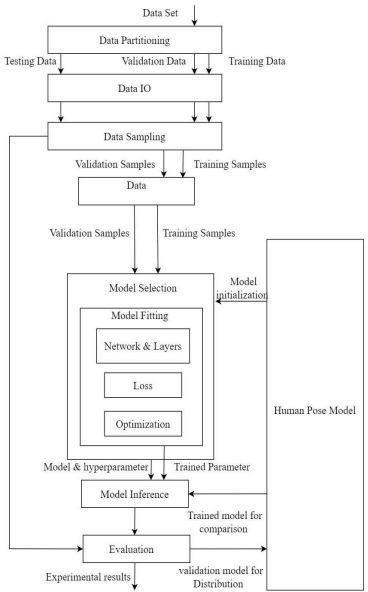
Themodelundergoesfitting,withlayersconfiguredfor extracting features and generating heatmaps and PAFs. Hyperparametersarefine-tunedtoenhanceperformance. Model inference applies the trained model to validation samples, followed by evaluation using metrics like accuracy, precision, recall, F1 score, and Mean Squared Error (MSE).
Experimental results provide insights into model performance, with comparisons to benchmark its effectiveness. The validated model is then prepared for deployment in a mobile application, allowing real-time poseestimationusingamobiledevice’sfrontcamera.This comprehensivedataflowensuresthemodelisaccurately trainedandcapableofeffectivehumanpose estimation.
TomaketheHPEmodelaccessibleanduser-friendly,we deployed it as a mobile application using Google’s Flutter framework. Flutter is an open-source framework that allows developerstocreatenatively compiledapplications for mobile,web, and desktop from a single codebase. This choice ensuredthat our application could run efficiently onvarious devices.
We used TensorFlow Lite to deploy the trained model on mobiledevices.TensorFlowLiteisalightweightversionof TensorFlowdesignedspecificallyformobileandembedded devices, providing efficient performance and low latency. Theapplication was equipped with features for real-time poseestimation,usingthefrontcamera ofamobiledevice tocapture and analyze poses.
The application's user interface was designed to be intuitive, allowing users to select different exercises or yoga poses and receive instant feedback on their performance. The feedback mechanism used visual indicators, such as green for correct poses and red for incorrect poses, to help users adjust their posture in real time.
The model’s performance was evaluated using standard metrics such as precision, recall, F1-score, and Mean Squared Error (MSE). Precision-measured the accuracy of key point detection, recall assessed the model’s ability to detectallrelevantkeypoints,andtheF1-scoreprovideda balancedmeasureofaccuracybycombiningprecisionand recall.MSEevaluatedthedifferencebetweenthepredicted and actual key point locations, quantitatively measuring themodel’saccuracy.
The Human Pose Estimation project achieved significant results through the implemented methodology. This section details the outcomes, including accuracy and loss analysis, heatmaps, part affinity fields, mobile application output,anderror analysis.
The training process involved monitoring the accuracy andlossmetricstoevaluatethemodel’sperformanceover successive epochs. The metrics provided insights into the

International Research Journal of Engineering and Technology (IRJET) e-ISSN: 2395-0056
Volume: 11 Issue: 08 | Aug 2024 www.irjet.net p-ISSN: 2395-0072
model’s learning progress and helped identify any potentialissues.
Epoch vs Training Accuracy: Training accuracy was tracked over each epoch to measure the model’s ability to correctly predict key points during the trainingphase.Thetrainingaccuracyshowedasteady improvement, indicating that the model was learning effectivelyfromthetrainingdata.
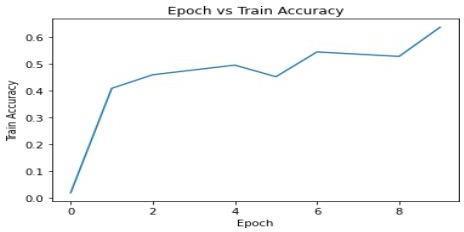
Figure-3. EpochvsTrainingAccuracy
Epoch vs Validation Accuracy: Validationaccuracywas tracked to measure the model’s performance on unseendata. Thismetricwascrucial forassessingthe model’sgeneralizationability.Thevalidationaccuracy also showed a consistent improvement, demonstrating that the model was not overfittingand could generalize well to new data.
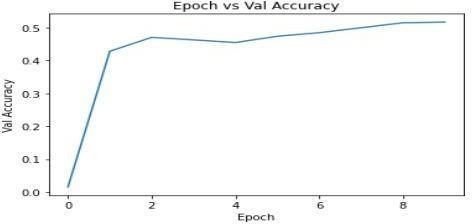
Figure-4: EpochvsValidationAccuracy
Epoch vs Training and Validation Accuracy: A combined plot of training and validation accuracy provided a comprehensive view of the model’s performance. Both metrics showed a similar trend, further confirming that the model was learning effectively without overfitting.
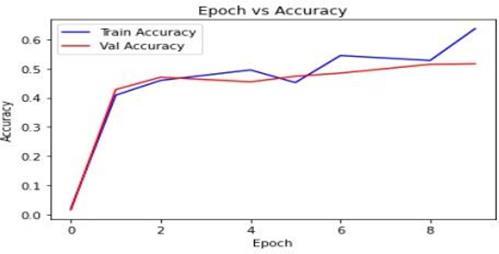
Figure-5: EpochvsTrainingandValidationAccuracy
Epoch vs Training Loss: Traininglosswasmonitoredto evaluate the model’s error in predicting key points during the training phase. The loss showed a decreasing trend, indicating that the model’s predictionswerebecomingmoreaccurateover time.
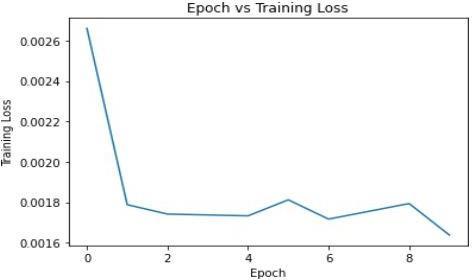
Figure-6: EpochvsTrainingLoss
The project successfully visualized human poses by detecting 17 key points and joining them to form a skeleton-likestructure.Thekeypointsincludedthenose, eyes, ears, shoulders, elbows, wrists, hips, knees, and ankles.
1. Heatmaps: Heatmaps were generated to visualize the probability of key point locations in a twodimensional space. The heatmaps provided a clear representation of where the model predicted each keypointtobe.Eachkeypointwasrepresentedbya separate heatmap, showing color variations to indicate the probability of the key point’s occurrence [21].

International Research Journal of Engineering and Technology (IRJET) e-ISSN: 2395-0056
Volume: 11 Issue: 08 | Aug 2024 www.irjet.net p-ISSN: 2395-0072
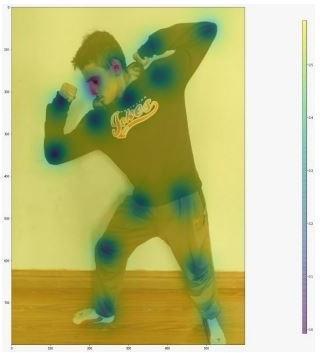
Figure-7: Heatmapofallkeypoints
Part Affinity Fields (PAFs) were used to depict the location and orientation oflimbs by forming pairs ofkey points. The PAFs were represented as 2D vector fields, providing direction vectors between key points that needed to be connected. The model generated a 32 32 34 matrix for PAFs, which was then processed using a greedy algorithm to identify the closestkey points and connectthem,formingacompletehumanskeleton.

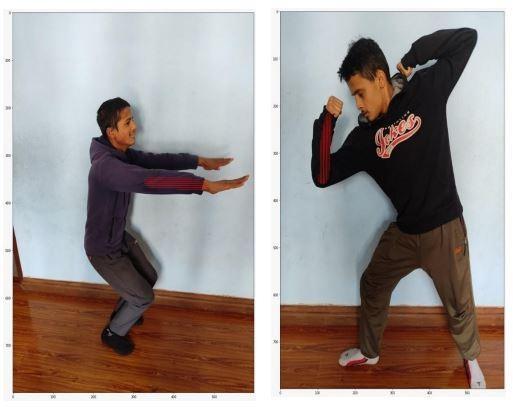
Figure-8: PAFofthebodypart
1) Joining Key Points and Final Output: The key points detected by the model were represented by different colors. These key points were then joined to form the final output, a skeleton-like structure that accurately representedthehumanpose.
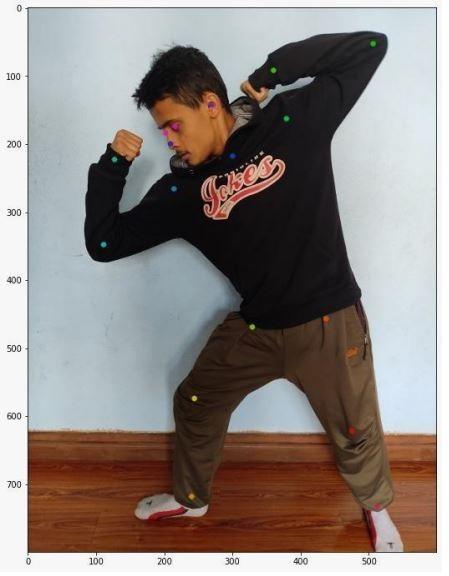
keypointsofbodyrepresentedbydifferent color
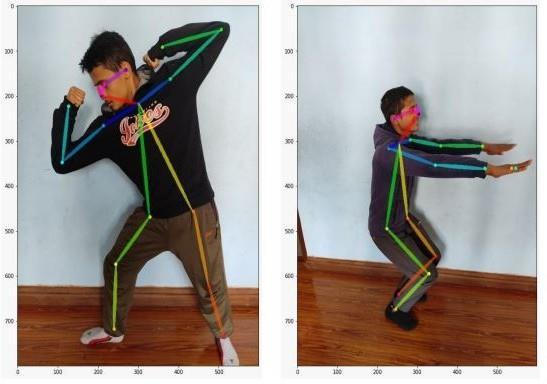
Figure-10: keypoint joining with the final output
Themodelwasdeployedinamobileapplicationtoprovide real-time pose estimation using the front camera of a mobile device.The application coulddetect exercises such as squats and arm raises, providing visual feedback to the userontheirperformance.

International Research Journal of Engineering and Technology (IRJET) e-ISSN: 2395-0056
Volume: 11 Issue: 08 | Aug 2024 www.irjet.net p-ISSN: 2395-0072
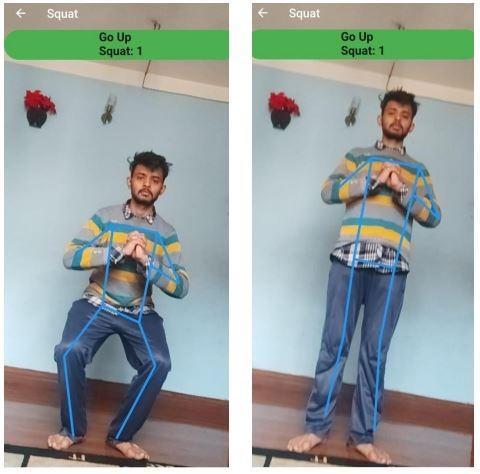
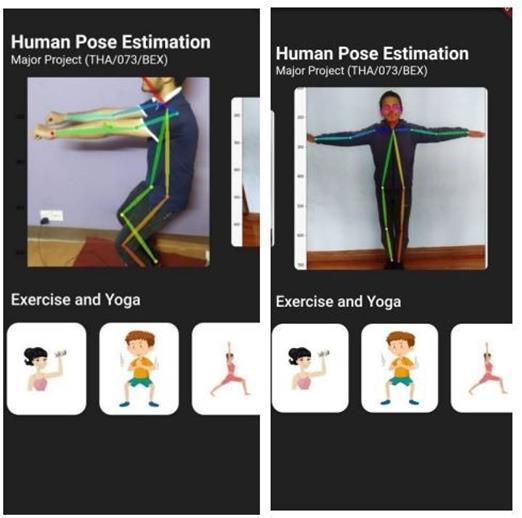
Figure-13:UIofyogaapp
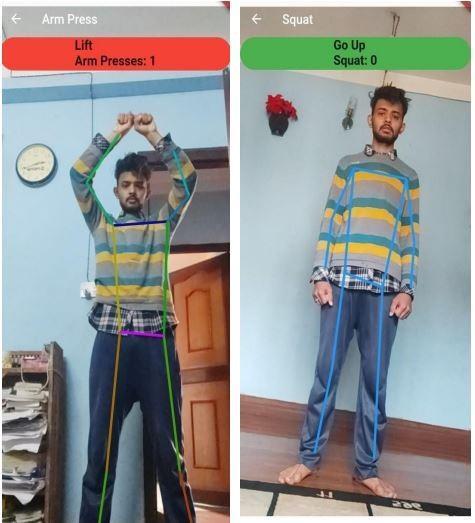
4.4. UI of Mobile App
Theuserinterfaceof themobileapplicationwasdesigned to be intuitive, allowing users to select exercises and receive instant feedback. The app displayed the detected key points and skeleton overlay on the camera feed, helping users adjust their posture in realtime.
5.Conclusion
The Human Pose Estimation project successfully demonstrated the ability to detect and visualize human posesusing deeplearningtechniques.Themodelachieved high accuracy in predicting key points and forming a skeleton-like structure, making it suitable for various applications such as exercise monitoring and interactive gaming. Despite the challenges and potential sources of error, the project provided reliableandconsistentresults, provingitsfeasibilityforreal-worlddeployment[22].
The project demonstrated significant potential for future enhancements, including:
Integrating face recognition and detection for defense applications.
Enhancing the system to predict user movements is usefulin defense and gaming.
Applying pose estimation in CGI for movies and video games.
Using3Dcamerasforcapturingthree-dimensionalhuman poses, provides better visualization and accuracy.
[1] N. Barla, "V7Labs," [Online]. Available: https://www.v7labs.com/blog/human-poseestimation-guide.

International Research Journal of Engineering and Technology (IRJET) e-ISSN: 2395-0056
Volume: 11 Issue: 08 | Aug 2024 www.irjet.net p-ISSN: 2395-0072
[2] P. Ganesh, "Towards Data Science," 15 March 2019. [Online]. Available: https://towardsdatascience.com/human-poseestimation-simplified-6cfd88542ab3.
[3] M. A. Fischler and R. A. Elschlager, "The Representation and Matching of Pictorial Structures," IEEETrans.Comput.,vol.C-22,no.1,pp.67-92,1973, doi:10.1109/T-C.1973.223602.
[4] P. F. Felzenszwalb and D. P. Huttenlocher, "Pictorial structures for object recognition," Int. J. Computer. Vis.,vol.61,no.1,pp.55-79,2005.
[5] L. Johnson and C. Everingham, "Clustered Pose and Nonlinear Appearance Models for Human Pose Estimation,"inProc.BritishMach.Vis.Conf.,2010,pp. 1-11,doi:10.5244/C.24.12.
[6] Y.Yorozu,M.Hirano,K.Oka,andY.Tagawa,"Electron spectroscopy studies on magneto-optical media and plastic substrate interface," IEEE Transl. J. Magn. Jpn., vol. 2, pp. 740-741, Aug. 1987 [Digests 9th Annual Conf.MagneticsJapan,p.301,1982].
[7] T.-Y. Lin et al., "Microsoft COCO: Common Objects in Context," in European Conf. Computer. Vis. (ECCV), 2014, pp. 740-755, doi: 10.1007/978-3-319-106021_48.
[8] M. Andriluka et al., "2D Human Pose Estimation: New Benchmark and State of the Art Analysis," in Proc. IEEE Conf. Comput. Vis. Pattern Recognit. (CVPR), 2014,pp.3686-3693,doi:10.1109/CVPR.2014.471.
[9] Z. Cao, G. Hidalgo, T. Simon, S.-E. Wei, and Y. Sheikh, "OpenPose: Realtime Multi-Person 2D Pose Estimation using Part Affinity Fields," IEEE Trans. Pattern Anal. Mach. Intell., vol. 43, no. 1, pp. 172-186, 2019,doi:10.1109/TPAMI.2019.2929257.
[10] L. Pishchulin et al., "DeepCut: Joint Subset Partition and Labeling for Multi-Person Pose Estimation," in Proc. IEEE Conf. Comput. Vis. Pattern Recognit. (CVPR), 2016, pp. 4929-4937, doi: 10.1109/CVPR.2016.533.
[11] H. Fang et al., "RMPE: Regional Multi-person Pose Estimation," in Proc. IEEE Int. Conf. Computer. Vis. (ICCV), 2017, pp. 2334-2343, doi: 10.1109/ICCV.2017.254.
[12] K. Simonyan and A. Zisserman, "Very Deep Convolutional Networks for Large-Scale Image Recognition,"arXivpreprintarXiv:1409.1556,2014.
[13] J. Wang et al., "Deep High-Resolution Representation Learning for Visual Recognition," IEEE Trans. Pattern
Anal. Mach. Intell., vol. 43, no. 10, pp. 3349-3364, 2020,doi:10.1109/TPAMI.2020.2983686.
[14] T.-Y.Lin,M.Maire,S.Belongie,L.Bourdev,R.Girshick, J. Hays, P. Perona, D. Ramanan, C. L. Zitnick, and P. Dollar,"MicrosoftCOCO:CommonObjectsinContext," in European Conf. Comput. Vis. (ECCV), Zurich, Switzerland,2014,pp.740-755.
[15] K. Simonyan and A. Zisserman, "Very Deep Convolutional Networks for Large-Scale Image Recognition," in Int. Conf. Learn. Representations (ICLR),SanDiego,USA,2015.
[16] Z. Cao, T. Simon, S.-E. Wei, and Y. Sheikh, "Realtime Multi-Person 2D Pose Estimation using Part Affinity Fields," in Proc. IEEE Conf. Computer. Vis. Pattern Recognit.(CVPR),SaltLakeCity,USA,2017,pp.72917299.
[17] D.P.KingmaandJ.Ba,"Adam:AMethodforStochastic Optimization," in Int. Conf. Learn. Representations (ICLR),SanDiego,USA,2015.
[18] X. Peng and K. Saenko, "Synthetic to Real Adaptation with Generative Correlation Alignment Networks," in Proc.IEEE WinterConf.Appl.Computer. Vis.(WACV), LakeTahoe,USA,2018,pp.1982-1991.
[19] A. Newell, K. Yang, and J. Deng, "Stacked Hourglass Networks for Human Pose Estimation," in European Conf.Computer.Vis.(ECCV),Amsterdam,Netherlands, 2016,pp.483-499.
[20] S. Johnson and M. Everingham, "Learning Effective Human Pose Estimation from Inaccurate Annotation," in Proc. IEEE Conf. Comput. Vis. Pattern Recognition. (CVPR),Boston,USA,2011,pp.1465-1472.
[21] D. Shrestha and D. Valles, "Evolving Autonomous Navigation: A NEAT Approach for Firefighting Rover OperationsinDynamicEnvironments,"in *2024 IEEE International Conference on Electro Information Technology(eIT)*,EauClaire,WI,USA,2024,pp.247255,doi:10.1109/eIT60633.2024.10609942.
[22] D. Shrestha, "Comparative Analysis of Machine Learning Algorithms for Heart Disease Prediction UsingtheClevelandHeartDiseaseDataset," Preprints, vol. 2024, no. 2024071333, 2024. https://doi.org/10.20944/preprints202407.1333.v1
2024, IRJET | Impact Factor value: 8.226 | ISO